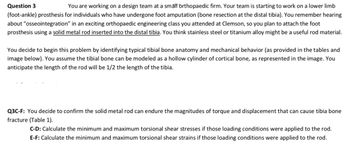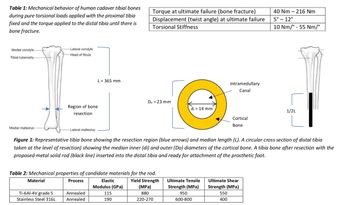
Elements Of Electromagnetics
7th Edition
ISBN: 9780190698614
Author: Sadiku, Matthew N. O.
Publisher: Oxford University Press
expand_more
expand_more
format_list_bulleted
Concept explainers
Question

Transcribed Image Text:Question 3
You are working on a design team at a small orthopaedic firm. Your team is starting to work on a lower limb
(foot-ankle) prosthesis for individuals who have undergone foot amputation (bone resection at the distal tibia). You remember hearing
about "osseointegration" in an exciting orthopaedic engineering class you attended at Clemson, so you plan to attach the foot
prosthesis using a solid metal rod inserted into the distal tibia. You think stainless steel or titanium alloy might be a useful rod material.
You decide to begin this problem by identifying typical tibial bone anatomy and mechanical behavior (as provided in the tables and
image below). You assume the tibial bone can be modeled as a hollow cylinder of cortical bone, as represented in the image. You
anticipate the length of the rod will be 1/2 the length of the tibia.
Q3C-F: You decide to confirm the solid metal rod can endure the magnitudes of torque and displacement that can cause tibia bone
fracture (Table 1).
C-D: Calculate the minimum and maximum torsional shear stresses if those loading conditions were applied to the rod.
E-F: Calculate the minimum and maximum torsional shear strains if those loading conditions were applied to the rod.

Transcribed Image Text:Table 1: Mechanical behavior of human cadaver tibial bones
during pure torsional loads applied with the proximal tibia
fixed and the torque applied to the distal tibia until there is
bone fracture.
Medial condyle
Tibial tuberosity-
Medial malleolus
-Lateral condyle
Head of fibula
Ti-6Al-4V grade 5
Stainless Steel 316L
Region of bone
resection
-Lateral malleolus
L = 365 mm
Annealed
Annealed
Torque at ultimate failure (bone fracture)
Displacement (twist angle) at ultimate failure
Torsional Stiffness
Table 2: Mechanical properties of candidate materials for the rod.
Material
Process
Yield Strength
(MPa)
880
220-270
Do = 23 mm
Elastic
Modulus (GPa)
115
190
d₁ = 14 mm
Figure 1: Representative tibia bone showing the resection region (blue arrows) and median length (L). A circular cross section of distal tibia
taken at the level of resection) showing the median inner (di) and outer (Do) diameters of the cortical bone. A tibia bone after resection with the
proposed metal solid rod (black line) inserted into the distal tibia and ready for attachment of the prosthetic foot.
Intramedullary
Canal
Ultimate Tensile
Strength (MPa)
950
600-800
Cortical
Bone
40 Nm-216 Nm
5° -12°
10 Nm/° - 55 Nm/°
Ultimate Shear
Strength (MPa)
550
400
1/2L
Expert Solution
This question has been solved!
Explore an expertly crafted, step-by-step solution for a thorough understanding of key concepts.
This is a popular solution
Trending nowThis is a popular solution!
Step by stepSolved in 5 steps with 6 images

Knowledge Booster
Learn more about
Need a deep-dive on the concept behind this application? Look no further. Learn more about this topic, mechanical-engineering and related others by exploring similar questions and additional content below.Similar questions
- Choose an application for each of the following materials and for each application state the key requirements and then explain why thst specific material ( quoting the material type I.e polyvinyl chloride) has the appropriate properties. A) metallic B) Ceramic C) Polymer D) composite materialarrow_forwardSummarize how at least two reference materials relate to the basic scientific principles of flying a paper plane. Each reference material must come from a different source. Be sure to describe how the references provide a foundational background for the experiment.arrow_forwardThis exercise requires showing the complete scanned strokes and procedures, adding it to a pdf document with evidence of all the exercises and the honesty letter. A Titanium specimen with a diameter of 0.8 [in] and 2.5 [in] in length is stretched in uniaxial tension. 1. What is the maximum elongation (DI) of the material. If the deformation is completely elastic? 2. What force is being applied Consider the material properties S_UTS=1205 [MPa]; Sy= 1075 [MPa]; E= 100 [GPa] in the following space write the values found as follows, do not forget the units (-0.5 pts if 4d units do not appear): ]; F= [];arrow_forward
- Other than wood nonferrous engineering materials can be divided into four categories they are polymers elastomers ceramics and glass and composites. True or false.arrow_forward7. Which of the following is false: a. The coefficient of thermal expansion is larger if the bond energy is smaller b. Ceramics are generally ionic bonding c. Van der Waals bonding is generally stronger than covalent bonding d. The free electrons in metallic bonding is reason for electrical conductivity 8. Which of the following is true: a. Polymers are generally denser than ceranmics b. Young's modulus of ceramics are similar to polymers c. Composites have higher tensile strength than metals d. Ceramics have low resistance to fracture than metalsarrow_forwardWhat’s the correct answer please?arrow_forward
- Task 1 You have been moved into the laboratory for the fluid testing for hydraulic devices and a considerable amount of research has been carried out in an attempt to understand the exact nature of the temperature variation of viscosity. Inspect the table given below and note the relative values of viscosity for each Newtonian fluid at a given temperature. Compare the results of a viscosity test and comment on why the viscosity of ethanol and water is considerably lower than motor oil and explain any discrepancies. Temperature [°C] Water (μ) Ethanol (μ) Motor oil (SAE 15W-40) (μ) [mPa s]/ cP [mPa s]/ cP [mPa s]/ cP 10 1.30600 1.4475 582.95 20 1.00160 1.1841 287.23 30 0.79722 0.9764 155.31 40 0.65272 0.8151 91.057 50 0.54650 0.694 57.172 60 0.46602 0.6034 38.071 70 0.40353 0.5231 26.576 80 0.35404 0.01043 19.358 90 0.31417 0.01074 14.588 100 0.28158 0.1104 11.316 To complete this task, it is required to evaluate the effects of shear force on three Newtonian and three non-Newtonian…arrow_forward9 Assignment Booklet 4B Science 24: Module 4 10. A 3-point belt, when worn properly, should fit A. snugly across the pelvis and loosely across the chest B. snugly across the pelvis and snugly across the chest G Joosely across the pelvis and loosely across the chest D. Joosely across the pelvis and snugly across the chest 11. A 4-point seat belt distributes forces more evenly across your and restrains both Return to page 79 of the Student Module Booklet and begin Lesson 3. Read question 12 carefully. Decide which of the choices BEST completes the statement. Place your answer in the blank space provided, 12. A modern air bag is designed to inflate in A. 0.330 s 27 B. 0.300 s C. 0.030 s D. 0.003 s up 10 (2 13. State two things an air bag is designed to do. 14. Explain why infant seats or small children should not be in the front passenger seat if the vehicle is equipped with a passenger-side air bag. 2 Submit your completed Assignment Booklet 4B to your teacher for assessment. Then return…arrow_forward
arrow_back_ios
arrow_forward_ios
Recommended textbooks for you
 Elements Of ElectromagneticsMechanical EngineeringISBN:9780190698614Author:Sadiku, Matthew N. O.Publisher:Oxford University Press
Elements Of ElectromagneticsMechanical EngineeringISBN:9780190698614Author:Sadiku, Matthew N. O.Publisher:Oxford University Press Mechanics of Materials (10th Edition)Mechanical EngineeringISBN:9780134319650Author:Russell C. HibbelerPublisher:PEARSON
Mechanics of Materials (10th Edition)Mechanical EngineeringISBN:9780134319650Author:Russell C. HibbelerPublisher:PEARSON Thermodynamics: An Engineering ApproachMechanical EngineeringISBN:9781259822674Author:Yunus A. Cengel Dr., Michael A. BolesPublisher:McGraw-Hill Education
Thermodynamics: An Engineering ApproachMechanical EngineeringISBN:9781259822674Author:Yunus A. Cengel Dr., Michael A. BolesPublisher:McGraw-Hill Education Control Systems EngineeringMechanical EngineeringISBN:9781118170519Author:Norman S. NisePublisher:WILEY
Control Systems EngineeringMechanical EngineeringISBN:9781118170519Author:Norman S. NisePublisher:WILEY Mechanics of Materials (MindTap Course List)Mechanical EngineeringISBN:9781337093347Author:Barry J. Goodno, James M. GerePublisher:Cengage Learning
Mechanics of Materials (MindTap Course List)Mechanical EngineeringISBN:9781337093347Author:Barry J. Goodno, James M. GerePublisher:Cengage Learning Engineering Mechanics: StaticsMechanical EngineeringISBN:9781118807330Author:James L. Meriam, L. G. Kraige, J. N. BoltonPublisher:WILEY
Engineering Mechanics: StaticsMechanical EngineeringISBN:9781118807330Author:James L. Meriam, L. G. Kraige, J. N. BoltonPublisher:WILEY

Elements Of Electromagnetics
Mechanical Engineering
ISBN:9780190698614
Author:Sadiku, Matthew N. O.
Publisher:Oxford University Press

Mechanics of Materials (10th Edition)
Mechanical Engineering
ISBN:9780134319650
Author:Russell C. Hibbeler
Publisher:PEARSON

Thermodynamics: An Engineering Approach
Mechanical Engineering
ISBN:9781259822674
Author:Yunus A. Cengel Dr., Michael A. Boles
Publisher:McGraw-Hill Education

Control Systems Engineering
Mechanical Engineering
ISBN:9781118170519
Author:Norman S. Nise
Publisher:WILEY

Mechanics of Materials (MindTap Course List)
Mechanical Engineering
ISBN:9781337093347
Author:Barry J. Goodno, James M. Gere
Publisher:Cengage Learning

Engineering Mechanics: Statics
Mechanical Engineering
ISBN:9781118807330
Author:James L. Meriam, L. G. Kraige, J. N. Bolton
Publisher:WILEY